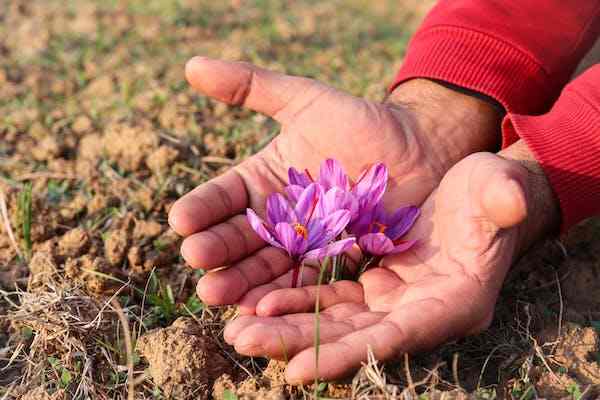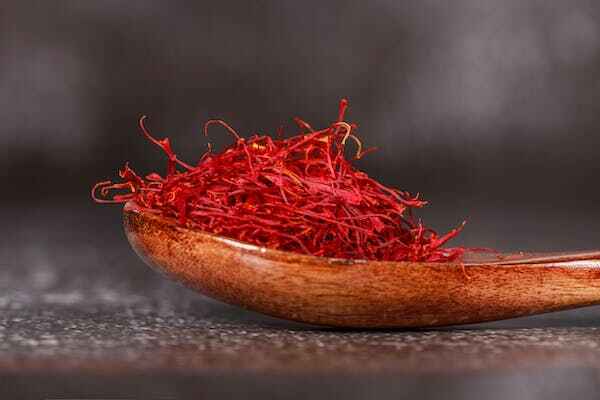People know saffron as a pricey spice. It tastes good and looks bright, but only a few try to grow it.
Maybe you must be thinking about growing saffron in America. And if you explore gardening or love saffron in food, this blog is for you.
We’ll explore how can you grow saffron in the US. We’ll check what saffron needs, from weather to care.
So let’s dive into saffron growing!

Characteristics of Saffron Flower
Saffron known as Crocus sativus in the science domain is a spice from the saffron crocus flower. Its uniqueness revolves around the vivid color, distinct taste, and pleasing fragrance, used across culinary, medicinal, and beautification fields for ages.
Let’s check out these characteristics of saffron
- Color: The glory of saffron lies in its lively crimson to maroon shades. This vibrancy originates from the trio of red stigmas, the flower’s feminine reproductive components, gathered by hand from each saffron crocus blossom.
- Flavor: Saffron has a somewhat bittersweet taste with a touch of earthiness. Its flavor stands out, subtly similar to honey, presenting noteworthy in various dishes.
- Aroma: Saffron’s scent is commonly depicted as floral, hay-ish, and a bit metallic. The smell is released when the strands get mashed or soaked in a liquid, infusing a pleasing aroma into the dishes.
- Chemical Composition: Saffron’s color, taste, and scent depend on key bioactive compounds—crocin, picrocrocin, and safranal. Crocin is responsible for the color, picrocrocin contributes to the saffron taste, and safranal is responsible for the aroma.
- Cultivation: Growing saffron bulbs demands specific conditions – well-drained soil, lots of sunlight, and a dry climate. Crocus flowers blossom in autumn, and in this season, the labor-intensive process of hand-harvesting extends.
- Geographical Origin: Saffron hails from Southwest Asia, with a rich cultivation history in nations like Iran, India, and Spain. Iran, especially, has a reputation for preparing top-notch saffron, often known as “Persian saffron.”
- Culinary Uses: Saffron, a spice with diverse applications globally, enhances various dishes like paella, risotto, biryani, and specific desserts. Its vivid color and distinctive flavor boost it to the status of a cherished and pricey spice.
- Medicinal Properties: Saffron, a long part of herbal remedies, is thought to pack antioxidants, soothe inflammation, and uplift moods. Caution is necessary – moderation in consumption is vital, and those with specific health issues should seek advice before medicinal use.
- Symbolism: Beyond being a spice, saffron carries cultural weight symbolizing luxury, wealth, and purity. In some traditions, it holds a role in religious observances and ceremonies.
- Preservation: Keep saffron in a cool, dark spot for color, flavor, and scent care. Commonly available as dried threads or powder, you should handle it with care.

Where Can You Grow Saffron in the United States?
Saffron blossoms in different parts of the United States, yet picking areas with fitting growing conditions is crucial. Optimal saffron growth demands a climate similar to the traditional Mediterranean setting.
You can consider these U.S. regions for potential success in cultivating saffron:
California, Arizona, and New Mexico offer climates conducive to saffron growth. These areas experience hot, arid summers and mild winters, simulating the conditions found in the Mediterranean.
In the Pacific Northwest, like segments of Oregon and Washington, saffron cultivation might find a home. The maritime climate, featuring gentle, rainy winters and arid summers, can prove one of the advantageous ways for how can you grow saffron in the US.
Heading to the Northeastern United States, places like New York and New England could be potential saffron havens. Still, paying attention to soil drainage and winter inactivity becomes pivotal in these parts.
In the Mountain West, high terrains in states like Colorado and Utah offer potential for saffron growth, particularly in zones with well-drained soils and chilly winters.
When considering saffron farming in the U.S., it’s crucial to look at distinct climate elements locally, such as temperature, rainfall, and soil features. Saffron farming demands precision, encouraging growers to thoroughly investigate and strategize. Seeking advice from regional agricultural extensions or seasoned saffron experts is cautious.
Moreover, initiating the process of how can you grow saffron in the US with top-notch saffron bulbs from trusted sources can be essential for a thriving saffron harvest.

How Can You Grow Saffron in The USA?
To cultivate saffron in the United States, you’ll require a warm, arid climate with well-draining ground. The saffron crocus bulbs grow in late summer or early fall, around 4–6 inches deep and spaced 4–6 inches apart.
Additional tips for how can you grow saffron in the US:
- Saffron can thrive in various soils, but it flourishes in well-drained, sandy, calcareous soil with ample humus.
- Plant bulbs in fresh soil to prevent pests and diseases from prior bulbous plants’ growth.
- Provide saffron plants with light watering, as they favor drier conditions.
- Saffron crocus corms dislike high humidity; the spot is 40–50 percent humidity.
- Saffron doesn’t endure cold well in USDA Zones 3–5.
- After autumn bloom, either migrate the corms or move the plants to a warmer, sheltered area.
- For selling saffron products, explore farmers’ markets or boost saffron visibility through spice cooking classes or tastings.

How long does saffron take to grow?
Saffron plants sprout in a garden within 6–10 weeks, but cultivated saffron demands nearly a year to flourish and blossom before reaping. Optimal for zones 6–10, saffron crocus (Crocus sativus) can thrive in garden plots or containers on patios or inside.
Growing tips for saffron crocus:
- Plant saffron bulbs in September or October.
- Pick a sunny spot in the garden where the earth drains nicely.
- Insert bulbs 2–3 inches deep, 3 inches apart, pointy ends skyward, and “hairy” side down.
Saffron cultivation goes through diverse stages, and the duration from planting to harvesting fluctuates.
- Within a few weeks post-planting, saffron corms usually sprout. The plant enters a vegetative growth period during the summer, fostering leaf development.
- As the autumn comes, the saffron plant takes a break, and its above-ground bits might wither.
- Saffron blossoms usually emerge in the fall, commonly from late September to November.
- The bloom hue varies with local conditions, presenting purple petals embracing three crimson stigmas (saffron threads).
- The saffron threads need to be harvested as soon as the flowers bloom because the stigmas are at their most powerful during this time. Harvesting is a delicate process as the threads are carefully plucked from each flower.
Conclusion: Can You Grow Saffron In The US
So let’s relish the charm of those delicate violet-colored saffron blossoms in your personal outdoor space. Though the procedure of how easily can you grow saffron in the US may demand effort, the delight of collecting your saffron is worthy, abundant in both taste and color and offers a unique adventure.
Related articles:


